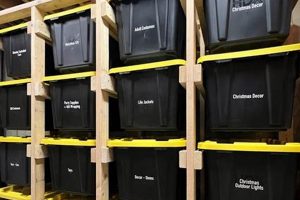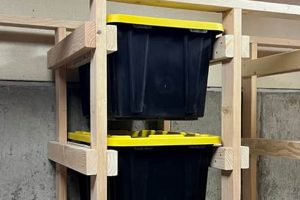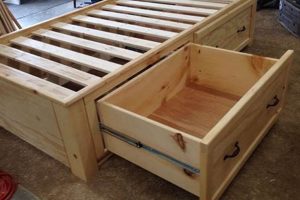The concept involves creating customized organizational systems within a pickup truck’s cargo area using self-made or modified components. These solutions often address the need for secure containment of tools, equipment, or other belongings, optimizing available space and preventing items from shifting during transit. For example, a fabricated drawer system constructed from plywood and equipped with locking mechanisms can provide compartmentalized storage for hand tools and hardware.
Such customized cargo management offers several advantages. It enhances security by providing concealed or lockable areas, deterring theft and protecting valuable items from the elements. Effective space utilization allows for increased carrying capacity and improved organization, which can be particularly beneficial for tradespeople, outdoor enthusiasts, or anyone who regularly transports equipment. Historically, individuals have modified their vehicles to suit specific needs, evolving from simple toolboxes to more sophisticated integrated systems.
The subsequent sections will detail various approaches to building such systems, discussing material selection, design considerations, and potential challenges. These topics will provide a framework for understanding the nuances of constructing a practical and durable storage solution.
Guidance for Truck Bed Customization
The following considerations are crucial for ensuring a successful implementation of a truck bed organizational system. Proper planning and execution will contribute to a durable and functional solution.
Tip 1: Prioritize Measurement Accuracy. Precise measurements of the truck bed’s interior dimensions are essential before commencing construction. Account for wheel wells, bed liner thickness, and any other permanent fixtures that may impact the available space. Inaccurate measurements can lead to ill-fitting components and compromised functionality.
Tip 2: Material Selection is Paramount. Choose materials based on durability, weather resistance, and intended load capacity. Pressure-treated lumber, marine-grade plywood, or steel offer superior resistance to moisture and wear compared to standard lumber. Consider the weight of the materials to avoid excessive burden on the vehicle’s suspension.
Tip 3: Security Integration is Recommended. Incorporate locking mechanisms into drawer systems or compartments to deter theft and secure valuable items. Heavy-duty latches, padlocks, or electronic locking systems can be integrated depending on the level of security required.
Tip 4: Weatherproofing Measures are Necessary. Implement weatherproofing strategies to protect stored items from the elements. Seal seams with silicone caulk, apply waterproof coatings to wood surfaces, and consider installing a bed cover or tonneau cover to provide an additional layer of protection.
Tip 5: Ergonomic Design Enhances Usability. Design the system with ergonomics in mind to ensure ease of access and comfortable operation. Consider drawer extension lengths, handle placement, and the overall height of the system to minimize strain and maximize efficiency.
Tip 6: Weight Distribution is Critical. Distribute the weight of the storage system and its contents evenly across the truck bed. Avoid concentrating weight in one area, as this can affect the vehicle’s handling and stability. Securely fasten the system to the truck bed to prevent shifting during transit.
Tip 7: Consider Modular Construction. Opt for a modular design that allows for future modifications or additions. Individual components can be easily removed, rearranged, or replaced as needed to adapt to changing storage requirements. This approach provides flexibility and extends the lifespan of the system.
Adhering to these guidelines will result in a well-designed and robust custom storage solution, improving the utility and organization of the vehicle.
The subsequent discussion will focus on specific design plans and project examples, providing further inspiration and practical guidance for realizing a personalized cargo management system.
1. Material Selection
Material selection constitutes a foundational decision in the creation of effective organizational systems for pickup truck beds. The chosen materials directly influence the structure’s durability, weather resistance, load-bearing capacity, and overall lifespan. Prudent consideration of material properties is therefore critical to the success of the project.
- Wood (Plywood, Dimensional Lumber)
Wood, particularly plywood and dimensional lumber, offers a balance of cost-effectiveness and workability. Plywood provides a stable, flat surface suitable for drawers and shelving, while dimensional lumber forms the structural framework. However, wood is susceptible to moisture damage, requiring treatment with sealants and preservatives. Marine-grade plywood offers enhanced water resistance but at a higher cost. Ineffective protection can lead to rot and structural failure.
- Metal (Steel, Aluminum)
Metal, such as steel or aluminum, provides superior strength and durability compared to wood. Steel offers high load-bearing capacity, making it suitable for heavy-duty applications. Aluminum, while lighter than steel, provides excellent corrosion resistance. However, metal requires specialized tools for cutting and welding. Steel is also prone to rust if not properly coated or painted. These materials are frequently used in more rugged solutions, offering long-term endurance.
- Composites (Plastic, Polymers)
Composite materials, including plastics and polymers, offer lightweight and weather-resistant alternatives. These materials are impervious to rust and rot, making them suitable for environments with high humidity or exposure to the elements. However, some composites may lack the structural strength of wood or metal and can be more expensive. Injection-molded plastics can create complex shapes and integrated features but require significant upfront investment in tooling.
- Fasteners (Screws, Bolts, Adhesives)
Beyond the primary construction materials, the selection of fasteners is critical. Screws and bolts must be appropriate for the chosen materials, providing secure and lasting connections. Stainless steel fasteners resist corrosion, while high-strength bolts offer increased shear strength. Adhesives, such as construction-grade epoxies, can supplement mechanical fasteners, creating stronger and more rigid joints. Improper fastener selection can lead to premature failure and structural instability.
The ultimate selection of materials for truck bed systems depends on a multitude of considerations, including budget, skill level, intended use, and environmental conditions. Each material offers a unique combination of properties that must be carefully evaluated to ensure the resulting structure meets the specific requirements of the application. Furthermore, the use of durable, high-quality materials will not only affect the lifespan of the constructed system, but will also improve the overall safety and performance of the truck bed organization system, and will reduce long-term repair and replacement expenses.
2. Design Planning
Effective truck bed solutions hinge on thorough design planning. The absence of a well-defined design frequently results in systems that fail to maximize space, lack structural integrity, or prove cumbersome to use. This phase dictates the overall functionality and efficiency of the final product, influencing factors ranging from material usage to accessibility of stored items. A carefully considered design serves as a blueprint, mitigating potential errors and ensuring alignment with the intended purpose.
Design planning encompasses several crucial steps. It starts with a needs assessment, identifying the specific items requiring storage and their respective dimensions. This assessment directly informs the dimensions and configuration of the storage compartments. Accurate measurements of the truck bed’s interior are then essential to ensure proper fitment and prevent wasted space. The design phase also necessitates the consideration of weight distribution, load-bearing capacity, and security measures. For example, a contractor transporting heavy tools would require a design that incorporates reinforced structures and secure locking mechanisms, whereas an outdoor enthusiast might prioritize lightweight materials and easy access to camping gear. Ignoring these factors leads to instability, potential damage to the vehicle, and increased risk of theft.
The design process culminates in a detailed plan that includes material specifications, dimensions, assembly instructions, and a clear visualization of the completed system. This plan serves as a roadmap, guiding the construction process and minimizing the likelihood of costly mistakes. The complexity of the design varies depending on the sophistication of the intended system. A simple toolbox requires minimal planning, while a multi-drawer system with integrated lighting and power outlets demands a more meticulous approach. Ultimately, investing time and effort in design planning yields significant returns in terms of functionality, durability, and overall satisfaction. A robust design reduces material waste, improves safety, and ensures the constructed organizational system effectively addresses the user’s specific needs.
3. Security Measures
The implementation of effective security measures represents a critical component of solutions for pickup truck beds. These measures directly mitigate the risk of theft and protect valuable tools, equipment, and personal belongings stored within the truck bed. The inherent accessibility of an open truck bed renders it vulnerable to unauthorized access; therefore, deliberate integration of security features is paramount.
A direct correlation exists between the level of security implemented and the probability of deterring theft. Basic measures, such as lockable toolboxes or tonneau covers, offer a degree of protection, while more sophisticated systems incorporating reinforced steel construction, electronic locking mechanisms, and alarm systems provide enhanced security. The selection of appropriate security measures depends on factors such as the value of the stored items, the environment in which the truck is operated, and the owner’s risk tolerance. For example, a construction worker storing expensive power tools in a high-crime area would require a more robust security system than a homeowner storing gardening supplies in a secure residential neighborhood. The absence of adequate security measures can result in significant financial losses and inconvenience due to theft or damage.
In conclusion, the incorporation of security measures is not merely an optional enhancement, but a necessary precaution for truck bed organizational systems. From basic locking mechanisms to sophisticated alarm systems, these features safeguard valuable assets and provide peace of mind. Prioritizing security during the design and construction phases ensures the longevity and practicality of the solution. Ignoring this aspect increases vulnerability and diminishes the overall utility of the system.
4. Space Optimization
Space optimization, in the context of truck bed solutions, directly addresses the efficient utilization of available volume within the vehicle’s cargo area. The limited dimensions of a truck bed necessitate strategic planning to maximize storage capacity without compromising accessibility or functionality. Improper space management results in underutilized areas, inefficient organization, and potential damage to stored items due to shifting during transit. Effective solutions prioritize the efficient arrangement of tools, equipment, and other belongings, ensuring secure containment and easy retrieval.
The correlation between space optimization and practical systems is evident in various applications. Consider a plumber who relies on a systematized truck bed setup to transport fittings, pipes, and specialized tools. A poorly designed storage system will result in wasted space, making it difficult to locate specific items and potentially leading to delays on job sites. Conversely, a well-optimized system, incorporating features such as vertical shelving, drawer dividers, and customized compartments, can significantly improve efficiency, reduce clutter, and minimize the risk of lost or damaged tools. Similarly, an overlander constructing a truck bed camping setup requires maximizing space for sleeping platforms, cooking equipment, and water storage. Such applications drive the demand for innovation in space-efficient designs.
In summary, the effective employment of strategies is fundamental to achieving the full potential of truck bed solutions. It is not merely about increasing storage volume but also about improving organization, accessibility, and overall efficiency. Challenges in achieving optimal space use often stem from inaccurate measurements, poor design planning, or inadequate material selection. Nonetheless, meticulous attention to spatial considerations yields significant benefits, enhancing the utility of the truck for both professional and recreational purposes. Further research into innovative design approaches and material advancements is vital to advancing the field of space-efficient organizational systems.
5. Weather Resistance
Weather resistance is a critical design consideration for any system intended for pickup truck beds. The open nature of a truck bed exposes its contents to a variety of environmental elements, including rain, snow, direct sunlight, and temperature fluctuations. Failure to adequately address these factors can lead to material degradation, corrosion, and damage to stored items. Therefore, the effective incorporation of weather-resistant features is essential to ensuring the longevity and functionality of solution.
The impact of environmental exposure on cargo and structure is multifaceted. Moisture intrusion can cause wood to rot, metal to rust, and fabrics to mildew. Prolonged exposure to ultraviolet (UV) radiation from sunlight can cause plastics to become brittle and paints to fade. Temperature extremes can cause materials to expand and contract, leading to stress and potential structural failure. For example, a solution constructed from untreated plywood and exposed to frequent rainfall will likely deteriorate rapidly, resulting in warping, delamination, and eventual collapse. Similarly, a metal system lacking a protective coating will be susceptible to rust and corrosion, compromising its structural integrity. Solutions intended for use in harsh climates require careful material selection and construction techniques to mitigate these risks. This might involve the use of marine-grade plywood, stainless steel hardware, waterproof coatings, and sealed seams to prevent moisture intrusion. Bed covers or tonneau covers can add a further layer of protection.
Ultimately, the long-term performance of a truck bed customization hinges on the selection of appropriate materials and the implementation of effective weather-resistant design features. Ignoring this aspect can lead to premature failure, increased maintenance costs, and potential damage to valuable equipment. Therefore, understanding the specific environmental challenges present in the intended operating environment and incorporating appropriate mitigation strategies is crucial for achieving a durable and reliable system.
6. Weight Distribution
Weight distribution represents a paramount concern in the design and implementation of storage solutions for pickup truck beds. The manner in which weight is distributed directly impacts vehicle handling, stability, and overall safety. Improper weight distribution can lead to compromised braking performance, reduced steering control, and accelerated wear on suspension components. Therefore, careful consideration of weight distribution is essential when planning and constructing these systems.
- Lateral Weight Balance
Lateral weight balance refers to the distribution of weight across the width of the truck bed. Uneven weight distribution from side to side can cause the vehicle to lean during cornering, affecting handling and stability. For instance, a system with heavy components concentrated on one side of the bed can lead to increased stress on the suspension components on that side. This can be corrected by strategically positioning heavier items to counterbalance each other, or by utilizing a symmetrical design. Ignoring lateral balance can result in unpredictable handling, particularly during emergency maneuvers.
- Front-to-Rear Weight Ratio
The front-to-rear weight ratio defines the proportion of weight distributed between the front and rear axles. Alterations to this ratio, such as adding a significant amount of weight behind the rear axle, can lighten the front end, reducing steering effectiveness and braking performance. This is especially pertinent in pickup trucks, which are often designed with a slightly rear-biased weight distribution when unloaded. A substantial addition of weight to the rear necessitates careful consideration to maintain adequate front-end traction and braking capability.
- Axle Load Limits
Every vehicle has specified axle load limits, which represent the maximum weight that each axle can safely support. Exceeding these limits can lead to component failure, such as broken springs, damaged axles, or tire blowouts. Calculating the weight of the completed system, including all stored contents, is crucial to ensuring that neither axle load limit is exceeded. This may require using lighter materials, reducing the overall size of the storage system, or strategically distributing weight to minimize stress on individual axles. These limitations are frequently found on a sticker on the driver’s side door.
- Center of Gravity Considerations
The center of gravity (CG) represents the point at which the weight of the vehicle and its contents is balanced. Raising the CG, such as by installing a tall and heavy storage system, can increase the risk of rollover, particularly during off-road driving or sharp turns. Designing the system to keep the CG as low as possible is essential for maintaining stability. This can be achieved by positioning heavier items low in the truck bed and avoiding excessively tall structures. The placement of a roof-top tent can greatly impact a vehicle’s center of gravity.
These facets underscore the importance of prioritizing weight distribution during the design and construction of truck bed solutions. Careful consideration of these principles not only ensures safe and predictable vehicle handling but also prolongs the lifespan of suspension components and reduces the risk of accidents. The design must account for these aspects, thereby creating a system that is both functional and safe for use.
Frequently Asked Questions
The following addresses commonly encountered questions regarding the construction of customized organizational systems within pickup truck beds. The answers provided aim to offer clarity on crucial aspects of design, material selection, and installation.
Question 1: What are the primary benefits of undertaking self-directed construction versus purchasing a pre-fabricated system?
Self-directed construction allows for complete customization to specific needs and truck bed dimensions, potentially resulting in a more efficient and space-optimized solution. It also offers the opportunity to select materials based on budget and durability requirements. Pre-fabricated systems, while offering convenience, may not perfectly align with individual requirements or truck bed configurations.
Question 2: What tools are typically required for constructing storage systems for pickup trucks?
The tools required vary depending on the materials used. However, a basic set typically includes a circular saw or jigsaw, drill, measuring tape, level, square, and a selection of hand tools such as screwdrivers and wrenches. If welding is involved, appropriate welding equipment and safety gear are necessary.
Question 3: How can one accurately measure a truck bed to ensure proper fitment of a system?
Accurate measurement requires taking multiple measurements at different points within the truck bed, accounting for any irregularities or obstructions such as wheel wells or bed liners. It is crucial to measure both the length and width at the floor and at the top edges of the bed sides, as these dimensions may differ. These measurements should serve as the basis for design plans.
Question 4: What are the key considerations for selecting materials to ensure durability and weather resistance?
Material selection should prioritize durability and resistance to environmental factors. Pressure-treated lumber, marine-grade plywood, and steel are commonly used due to their resistance to moisture and wear. All wood components should be sealed with a waterproof coating, and metal components should be painted or powder-coated to prevent rust. Fasteners should be corrosion-resistant.
Question 5: How can weight be effectively distributed within a system to prevent negative impacts on vehicle handling?
Weight distribution should aim to maintain a balanced load across the truck bed, avoiding excessive concentration of weight on one side or towards the rear. Heavier items should be positioned over or near the axles to minimize their impact on vehicle handling and stability. The overall weight of the system, including its contents, must not exceed the vehicle’s specified weight limits.
Question 6: What security measures can be incorporated to deter theft of tools and equipment stored in a system?
Security measures can include lockable drawers and compartments, reinforced steel construction, and alarm systems. Concealing the contents of the system with a tonneau cover or bed cap can also deter theft. High-quality locking mechanisms and tamper-resistant hardware are essential.
Proper planning and execution are critical for the successful construction of a durable and functional organizational system. Prioritizing accurate measurements, appropriate material selection, and secure installation are all essential.
The following section will explore various project examples that showcase the practical application of these principles, providing further inspiration and guidance for those considering the implementation of a customized cargo management solution.
Conclusion
The preceding analysis has explored diverse facets of the term “diy truck bed storage,” encompassing design principles, material selection, security considerations, and weight management strategies. These elements, when meticulously addressed, yield a robust and adaptable system tailored to specific needs.
Further investigation into innovative designs and material advancements is warranted to optimize the utility and longevity of “diy truck bed storage.” The informed application of these concepts enables the construction of secure, organized, and durable solutions, enhancing the practicality and value of the pickup truck.







![Build Your Own! Storage Bin Rack DIY Project [Easy] The DIY Hub: Creative Crafts, Repairs & Life Hacks Build Your Own! Storage Bin Rack DIY Project [Easy] | The DIY Hub: Creative Crafts, Repairs & Life Hacks](https://craftingdiycenter.com/wp-content/uploads/2025/07/th-1825-300x200.jpg)